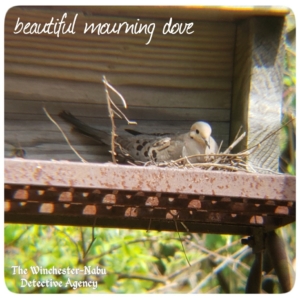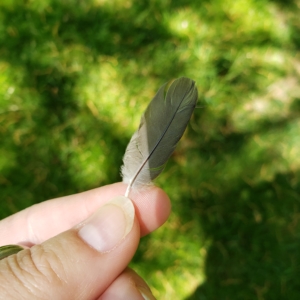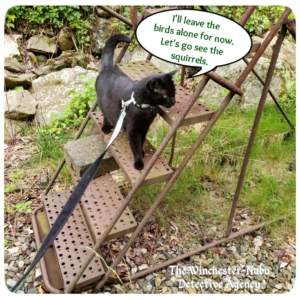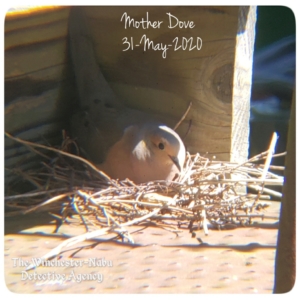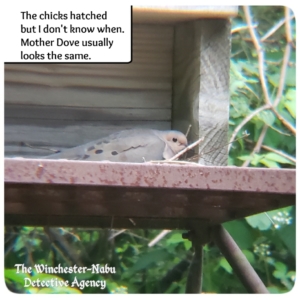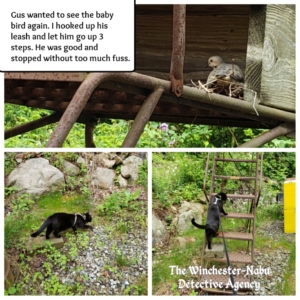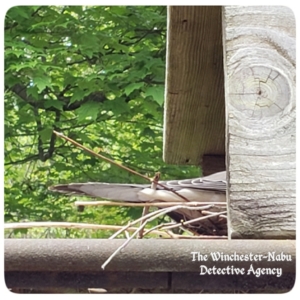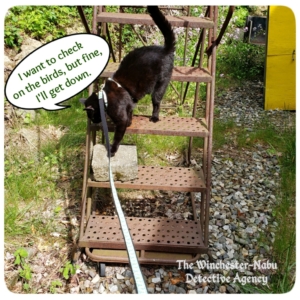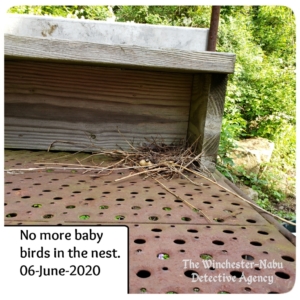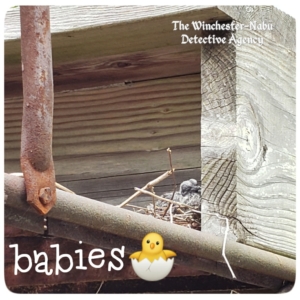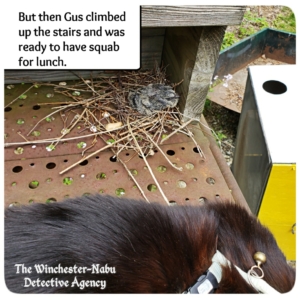Winchester-Nabu Detective Agency Year Four:
Case File No. 11-167
AMBER LOVE 27-JULY-2020 Find out how all this began. Catch up on Year One, Year Two, and Year Three cases at the Winchester-Nabu Detective Agency. Thank you for all your financial and social support! Oliver and Gus are looking forward to bringing you more fascinating discoveries and investigations into the chipmunk mafia, the blue jay gang, the neighborhood critters, and cryptid sightings.
This work is supported by the generous backers who adore my cat stories at Patreon.com/amberunmasked and they also get first access to what’s happening with my books and podcast. For a one-time tip, you can go to the new PayPal.me.
Where We Left Off:
We conducted genealogy research on a rather curious chipmunk named Ms. Calendula Thorne.
The Clay Pigeon:
From the end of May into the beginning of June, Gus and I had a particularly interesting scientific endeavor. We got to monitor one of the mourning dove couples (they mate for life) laying eggs. The doves chose a location that may not have been the safest in terms of protecting them from predators, but it was an excellent spot for observations. It’s not quite the experience of Eurasian Eagle Owls nesting on your windowsill, but it was still super cool for us to watch and for Gus to interact with something brand new to him.
When I say Gus interacted with the mourning doves, I am being literal. It’s not as if he climbs up this metal staircase in the junkyard on a regular basis, but he does go up there from time to time. The nest was right on the top landing of the stairs and nestled into the additional wooden step. Gus had been looking for chipmunks in the embankment called Garter Snake Ridge, but his Super Smeller told him that something else deserved his attention. His nose led him over to the staircase.
He approached the stairs in such a different way than his normal spying on wildlife demeanor. The Super Smeller said whatever it was, the creatures were right there. So close. Within reach. He skulked quietly and carefully. I didn’t want to spook Mother Dove either, but I knew I had to intercede. I reached Gus when he was nearly at the top. I had to step up in order to hook his leash back to his harness.
Honestly, I think Gus was going to be gentle (at first) in order to investigate with feline curiosity. It was Mother Dove who got startled first. She reared back and flapped her broad wings, but took off in self-preservation mode having to leave her two eggs behind.
I am quite shocked that I didn’t fall backwards off the staircase given my penchant for falling off trees and logs. I had a good hold on Gus so he couldn’t attack her before she flew away. I let him smell the nest and the eggs. I was worried about an old wives’ tale I had been told: that if you told a bird’s nest or the chicks that the mothers won’t come back and they’ll be rejected. That was said in terms of any wildlife babies, but I specifically remember hearing it first about birds. I wasn’t touching the eggs or nest. Gus was. I was so worried after that wondering if the mother would return to tend to the eggs or if we just ruined her little family.
“The oldest known Mourning Dove was a male, and at least 30 years, 4 months old when he was shot in Florida in 1998. He had been banded in Georgia in 1968.” allaboutbirds (Cornell University)
Fortunately, Mother Dove did return. I could see her once Gus and I got far away. I saw her perched high on the metal railing keeping watch for Gus to return. What I found so interesting about her behavior was that she always kept her cool when we walked through the junkyard. I normally tried to use a little zoom lens to get pictures, but honestly, there were plenty of times when I was right next to the staircase while we watched the squirrels and birds at the feeder tree.
I could never tell when the eggs hatched. Back when the columns on the house were different and finches would nest in them every year, we heard the babies chirping at feeding time. I guess Gus and I were never at the staircase during feeding time. It was always perfectly still.
Another time when Mother Dove left, Gus and I snuck up the stairs to see if there was any news on the eggs. The baby that was there was quite large. I can’t even be certain it was one baby since there were two eggs. It may have been two of them nestled so close together. Another fascinating fact is that mourning doves almost always lay two white eggs. Our observations began May 11th. By June 6th, the mother and babies had vacated the nest. Gus was allowed to inspect the nest and roost area without intervention.
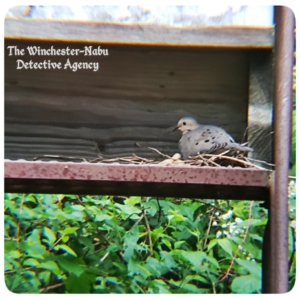
The Cook has hated mourning doves her whole life because they’re named “mourning” rather than “morning” and it creeps her out as if Death is near. I’ve been trying to say nice things about these doves to change her opinion of them. I keep saying that they’re pretty and have sweet behaviors compared to their relatives, the rock pigeon which is abundant in big cities like New York and London and associated with filth and disease. Rock pigeons are pretty too, but people either love them or hate them.
Depending on where the doves live, a mated pair can have two to six broods annually! I read other facts about mourning doves at abirdsdelight.com. According to backyardbirdingblog and Cornell, the mourning dove is the most hunted game bird species in North America. The go-to experts at Cornell also have this note: “During the breeding season, you might see three Mourning Doves flying in tight formation, one after another. This is a form of social display. Typically the bird in the lead is the male of a mated pair. The second bird is an unmated male chasing his rival from the area where he hopes to nest. The third is the female of the mated pair, which seems to go along for the ride.”
Case Findings:
Gus conducted a study on the breeding of mourning doves in the junkyard. His first instinct was to be hands-on though gentle. He had an interaction with Mother Dove and realized he needed to respect her space until after the babies were hatched and gone. Oliver didn’t have any information in his files about this pair of mourning doves. We don’t know where they like to migrate in the cold season or what their roles are in the estate area wildlife community. They seem like a courageous couple, resilient based on where they chose to roost. We’ll take note if there are any rumblings about these doves getting involved in keeping the peace between the Chipmunk Mafia and the Blue Jay Gang.
Case Status: Closed


